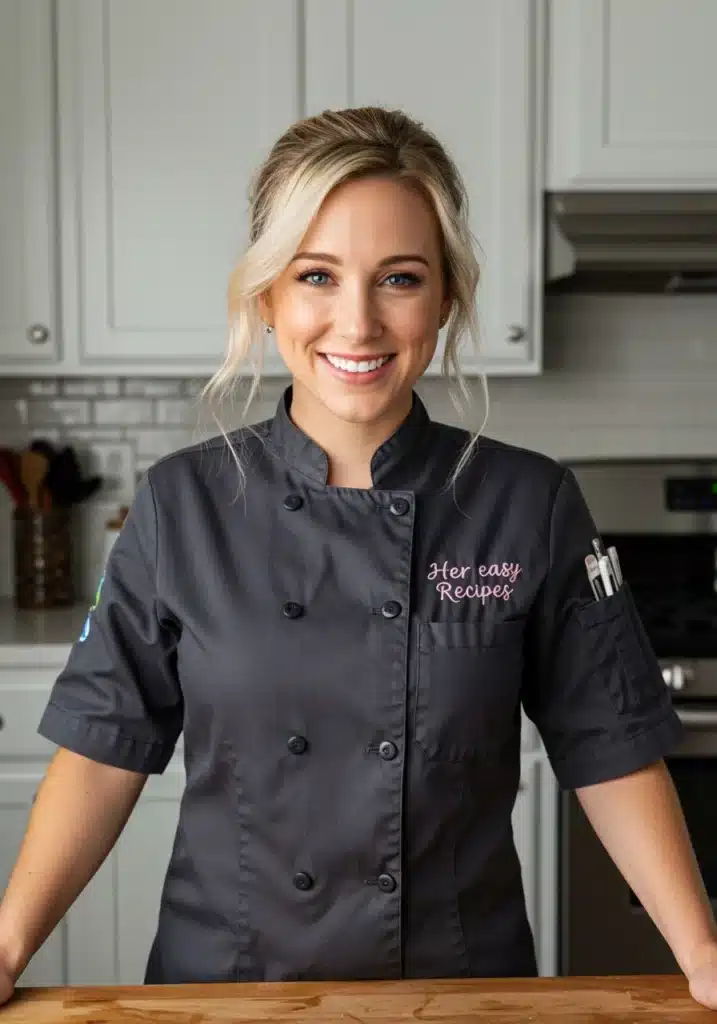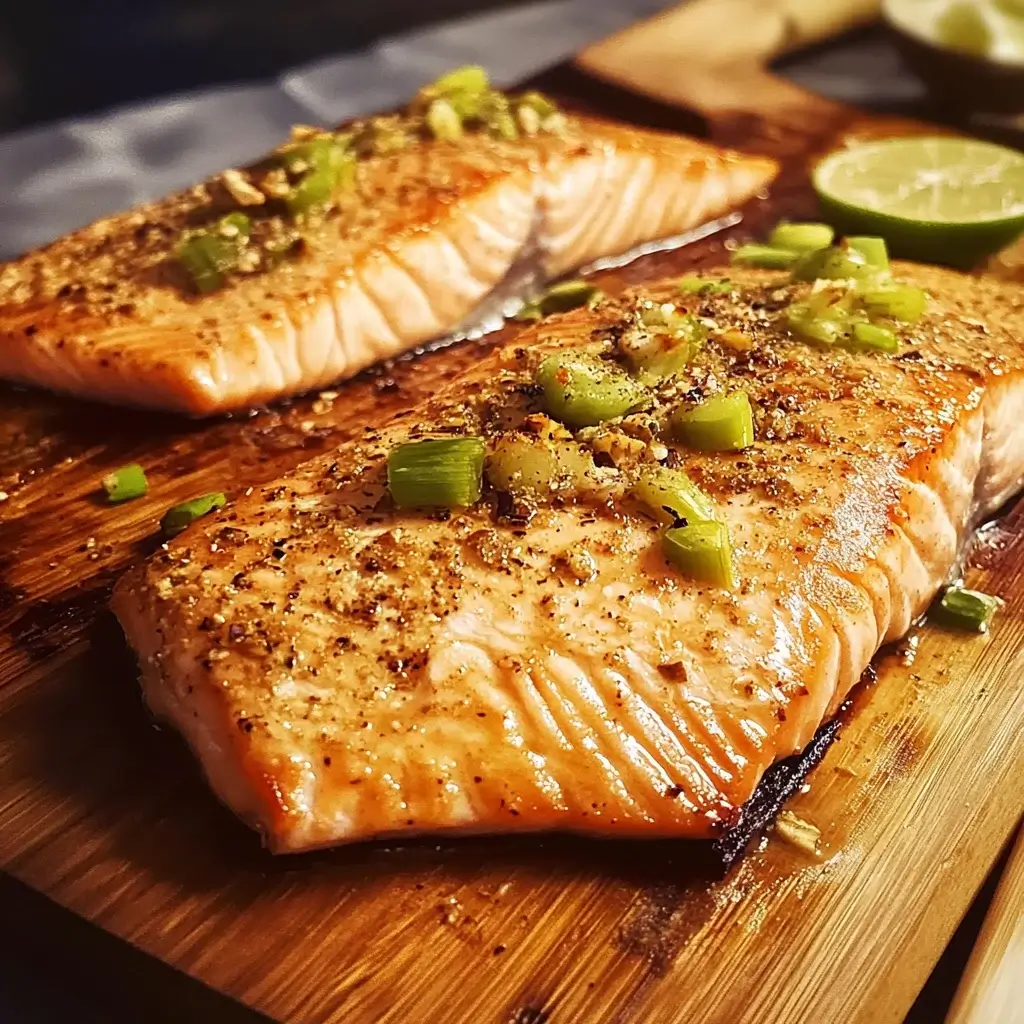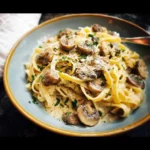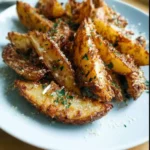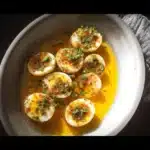Summer barbecues in our backyard are a cherished tradition, but sometimes, amidst the burgers and steaks, we crave something a little more refined, a little more… special. That’s when Cedar Plank Salmon BBQ enters the scene and completely steals the show. The first time I tried cedar plank salmon, it was at a friend’s outdoor gathering, and the aroma alone was intoxicating. That distinct smoky cedar scent mingling with the delicate fragrance of cooking salmon – it was pure culinary magic. When I finally attempted it myself at home, the results were even better than I imagined. The salmon, infused with the subtle woodsy notes from the cedar plank, was incredibly moist, flaky, and bursting with flavor. My family, initially skeptical about “salmon on a plank,” were instantly converted. The kids loved the unique presentation and the tender, flavorful fish, and my husband, a grilling enthusiast, was impressed by the ease and the depth of flavor achieved. Cedar plank salmon has since become our go-to for summer gatherings, impressing guests and satisfying our own cravings for a healthy, flavorful, and utterly unforgettable BBQ experience. If you’re looking to elevate your grilling game and unlock a new dimension of flavor in your salmon, prepare to be amazed by the simple yet transformative technique of cedar plank BBQ. This recipe is your gateway to smoky, succulent salmon that will have everyone asking for seconds.
Ingredients: The Essence of Smoky, Succulent Salmon
The ingredient list for Cedar Plank Salmon BBQ is wonderfully straightforward, allowing the natural flavors of the salmon and the cedar plank to truly shine. Each element plays a vital role in creating the signature smoky, moist, and flavorful dish. Let’s explore each ingredient and understand its contribution to the overall BBQ experience.
- 1.5 lbs Salmon Fillet (Skin-on, Center-Cut preferred): The quality and type of salmon are paramount for a truly exceptional Cedar Plank Salmon BBQ. Choosing the right fillet ensures optimal flavor, texture, and cooking results.
- Salmon Type: While various types of salmon can be used, certain varieties are particularly well-suited for cedar plank grilling due to their fat content and flavor profile.
- King Salmon (Chinook): Often considered the pinnacle of salmon, King salmon is prized for its rich, buttery flavor and high fat content. This fat content is crucial for cedar plank grilling as it keeps the salmon incredibly moist and prevents it from drying out during cooking. King salmon imparts a luxurious, melt-in-your-mouth texture and a deeply satisfying flavor infused with cedar smoke.
- Sockeye Salmon (Red Salmon): Sockeye salmon is another excellent choice, offering a robust, “salmon-y” flavor and a firm, meaty texture. While leaner than King salmon, Sockeye still has enough fat to remain moist and flavorful when cedar plank grilled. Its distinct flavor profile stands up beautifully to the smoky cedar notes.
- Coho Salmon (Silver Salmon): Coho salmon is a milder and more versatile option, offering a delicate flavor and a medium-firm texture. It’s a good balance between flavor and affordability and works well for those who prefer a less intense salmon taste. Coho salmon also benefits greatly from the smoky infusion of cedar plank grilling.
- Atlantic Salmon (Farmed or Wild-Caught): Atlantic salmon, both farmed and wild-caught, can be used. Wild-caught Atlantic salmon tends to be leaner and has a more pronounced flavor. Farmed Atlantic salmon is generally fattier and more readily available. When using Atlantic salmon, especially farmed varieties, ensure you don’t overcook it to maintain moisture.
- Skin-On vs. Skin-Off: Skin-on salmon is highly recommended for cedar plank grilling. The skin acts as a protective barrier between the salmon flesh and the direct heat of the grill, helping to prevent sticking and keeping the salmon incredibly moist. Furthermore, the skin crisps up beautifully when placed directly on the plank during grilling, adding a delightful textural contrast. Center-cut fillets, which are thicker and more uniform, cook more evenly and are ideal for presentation and consistent results.
- Salmon Type: While various types of salmon can be used, certain varieties are particularly well-suited for cedar plank grilling due to their fat content and flavor profile.
- 1 Cedar Plank (Untreated, Food-Grade, approximately 12-15 inches long): The cedar plank is the defining element of this recipe, imparting its signature smoky aroma and flavor to the salmon. Choosing the right plank and preparing it correctly is essential for safety and flavor.
- Type of Cedar Plank: Use only untreated, food-grade cedar planks specifically sold for grilling. These planks are typically made from Western Red Cedar, known for its aromatic and food-safe properties. Avoid using lumberyard cedar, as it may be treated with chemicals that are not food-safe and can impart unpleasant flavors.
- Plank Size: A plank approximately 12-15 inches long and 5-7 inches wide is generally suitable for a 1.5 lb salmon fillet. Ensure the plank is large enough to comfortably accommodate the salmon fillet without overhang.
- Soaking the Plank: Soaking the cedar plank in water is a crucial step. Soaking prevents the plank from catching fire on the grill and allows it to smolder and release its smoky aroma slowly. Soak the plank for at least 2-4 hours, or ideally overnight, submerged in water. You can weigh it down with a heavy can or plate to keep it fully submerged. For added flavor, you can soak the plank in wine, beer, apple cider, or even broth instead of water, although water works perfectly well for a classic cedar flavor.
- 2 tablespoons Olive Oil (Extra Virgin): Olive oil is used to brush the cedar plank and the salmon fillet, preventing sticking and adding a subtle richness and flavor. Extra virgin olive oil is preferred for its robust flavor and health benefits.
- 2 tablespoons Lemon Juice, Freshly Squeezed: Fresh lemon juice brightens the flavor of the salmon, adds acidity, and complements the smoky cedar notes beautifully. Freshly squeezed lemon juice is crucial for its vibrant and fresh taste.
- 2 cloves Garlic, Minced: Minced garlic adds a savory, aromatic depth to the salmon that enhances its natural flavor and pairs well with the smoky cedar. Freshly minced garlic is preferred for its pungent and robust taste.
- 1 teaspoon Dried Dill (or 2 tablespoons Fresh Dill, chopped): Dill is a classic herb that pairs exceptionally well with salmon, adding a fresh, herbaceous, and slightly citrusy note that complements the smoky cedar and lemon. Dried dill is convenient, but fresh dill, when available, offers a more vibrant and aromatic flavor.
- Salt and Black Pepper to taste: Essential seasonings that enhance all the other flavors and bring the dish together. Seasoning to taste is crucial, as the amount needed can vary depending on individual preferences and the natural saltiness of the salmon. Kosher salt or sea salt and freshly ground black pepper are recommended for the best flavor.
- Optional Garnishes (for presentation and added freshness):
- Fresh Dill Sprigs: Fresh dill sprigs add a beautiful visual garnish and a burst of fresh dill aroma when serving.
- Lemon Slices or Wedges: Lemon slices or wedges provide an extra squeeze of fresh lemon juice at the table, enhancing the brightness and tanginess of the dish.
- Chopped Fresh Parsley: Chopped fresh parsley adds a pop of color and a fresh, herbaceous note.
Instructions: Mastering the Art of Cedar Plank Salmon BBQ
Creating perfectly cooked Cedar Plank Salmon BBQ is a straightforward process, but attention to detail in each step is key to achieving optimal flavor and texture. Follow these detailed instructions to guide you through each stage of the process, from plank preparation to grilling and serving.
Step 1: Prepare the Cedar Plank (Crucial Pre-Grilling Step)
- Soak the Cedar Plank: Place the cedar plank in a large container or baking dish and cover it completely with water. Ensure the plank is fully submerged by weighing it down with a heavy can, plate, or bowl. Soak for at least 2-4 hours, or ideally overnight. Longer soaking times are preferable to ensure the plank is thoroughly saturated with water. This step is absolutely essential to prevent the plank from catching fire on the grill and to ensure it smolders and releases smoke instead of burning.
Step 2: Prepare the Salmon and Seasonings (Flavor Infusion)
- Pat Salmon Dry: Remove the salmon fillet from its packaging and pat it dry with paper towels. Patting the salmon dry helps seasonings adhere better and promotes better searing if you choose to sear it briefly before planking.
- Prepare Seasoning Mixture: In a small bowl, combine minced garlic, dried dill (or fresh dill), salt, and black pepper. Mix well to ensure the seasonings are evenly distributed.
- Season Salmon: Place the salmon fillet on a cutting board or plate. Drizzle olive oil over the top of the salmon fillet, spreading it evenly with your fingers or a brush. Sprinkle the seasoning mixture evenly over the salmon fillet, pressing gently to help the seasonings adhere. Squeeze fresh lemon juice over the seasoned salmon fillet, ensuring it is evenly distributed.
Step 3: Prepare the Grill (Setting the Stage for Smoky Grilling)
- Preheat Grill: Preheat your grill to medium heat (around 350-400°F or 175-200°C). Medium heat is ideal for cedar plank grilling, allowing the salmon to cook through gently and evenly without burning the plank or drying out the fish. If using a charcoal grill, arrange the coals for indirect heat, meaning you will place the plank and salmon away from the direct flames. For a gas grill, preheat with all burners on medium, then adjust as needed to maintain medium heat.
- Prepare Soaked Cedar Plank: Remove the soaked cedar plank from the water and pat it dry with paper towels. Patting it dry slightly helps to prevent excessive steaming initially and encourages the plank to start smoldering and smoking sooner.
Step 4: Grill the Cedar Plank Salmon (The Smoky Transformation)
- Place Plank on Grill: Place the soaked cedar plank directly on the preheated grill grates over indirect heat (if using charcoal) or on a cooler zone of the grill (if using gas). Close the grill lid and heat the plank for about 5-10 minutes, or until you start to hear it crackle and see it begin to smoke lightly. Heating the plank first preheats it and encourages it to start smoking before the salmon is placed on top. Watch closely to ensure the plank doesn’t catch fire. If it flames up, use a spray bottle of water to gently extinguish the flames.
- Place Salmon on Plank: Carefully place the seasoned salmon fillet, skin-side down, directly onto the preheated cedar plank on the grill. Close the grill lid.
- Grill Time and Temperature: Grill the cedar plank salmon for 15-20 minutes, or until the salmon is cooked through and flakes easily with a fork. The exact grilling time will depend on the thickness of the salmon fillet and the heat of your grill. Maintain medium heat throughout the grilling process. Avoid lifting the lid too frequently to maintain consistent temperature and smoke infusion.
- Check for Doneness: Salmon is cooked through when it flakes easily with a fork and is no longer translucent in the center. You can use a meat thermometer to check the internal temperature; it should reach 145°F (63°C). Be careful not to overcook the salmon, as it can become dry. Cedar plank grilling helps to prevent overcooking due to the gentle, indirect heat and the moisture released from the plank.
Step 5: Serve and Garnish (Presenting the Smoky Delight)
- Remove from Grill: Once the salmon is cooked through, carefully remove the cedar plank with the salmon from the grill using large tongs or spatulas. Place the plank on a heatproof serving platter or cutting board.
- Garnish (Optional): Garnish the cedar plank salmon with fresh dill sprigs, lemon slices or wedges, and chopped fresh parsley, if desired, for visual appeal and added freshness.
- Serve Immediately: Serve the Cedar Plank Salmon BBQ immediately while it is hot, flaky, and infused with smoky cedar flavor. You can serve the salmon directly from the plank for a rustic and impressive presentation, or carefully transfer the salmon fillet to a serving platter and discard the plank. Serve with your favorite sides (see serving suggestions below).
Nutrition Facts
(Note: Nutritional information is an estimate and can vary based on specific ingredients used, serving size, type of salmon, and cooking methods. The following is a rough estimate per serving, assuming the recipe makes approximately 4-6 servings.)
- Servings: Approximately 4-6 servings
- Calories per serving (estimate): 400-600 calories
Approximate Nutritional Breakdown per Serving (Estimate – can vary widely):
- Calories: 500
- Total Fat: 30-40g (depending on salmon type)
- Saturated Fat: 5-8g (depending on salmon type)
- Cholesterol: 120-150mg (depending on salmon type)
- Sodium: 200-300mg (depending on added salt)
- Total Carbohydrate: 2-3g
- Dietary Fiber: 0-1g
- Sugars: 1-2g (naturally occurring in salmon and lemon juice)
- Protein: 40-50g
Disclaimer: These values are estimates and for informational purposes only. For precise nutritional information, use a nutrition calculator with the specific brands and quantities of ingredients you use, particularly considering the wide range of salmon types and fillet sizes. Salmon is naturally rich in omega-3 fatty acids, protein, and Vitamin D.
Preparation Time
Cedar Plank Salmon BBQ requires some advance preparation due to the plank soaking time, but the active cooking and preparation time is relatively short, making it manageable for weeknight dinners or weekend BBQs.
- Prep Time: 20 minutes (includes salmon seasoning, plank soaking preparation)
- Soaking Time: 2-4 hours minimum (ideally overnight)
- Cook Time: 20-25 minutes (includes plank preheating and salmon grilling)
- Total Time: Approximately 2 hours 40 minutes – 4 hours 45 minutes (including soaking time)
Active Time: Approximately 40-45 minutes (prep and grilling)
Passive Time: Approximately 2-4 hours (plank soaking)
How to Serve Cedar Plank Salmon BBQ: Complementary Sides and Presentation
Cedar Plank Salmon BBQ is a versatile dish that pairs beautifully with a wide range of side dishes, enhancing the overall BBQ experience. Here are some serving suggestions to create a complete and memorable meal:
- Classic BBQ Sides:
- Grilled Vegetables: Grilled asparagus, zucchini, bell peppers, corn on the cob, or cherry tomatoes are excellent choices that complement the smoky salmon and grilling theme.
- Potato Salad: Creamy potato salad, German potato salad, or grilled potato wedges provide a hearty and satisfying side.
- Coleslaw: Creamy coleslaw or vinegar-based coleslaw offers a cool and crunchy contrast to the rich salmon.
- Baked Beans: Sweet and smoky baked beans are a classic BBQ side that pairs well with the cedar plank salmon.
- Cornbread: Warm cornbread or corn muffins are a comforting and delicious accompaniment.
- Fresh and Light Sides:
- Salads: A fresh green salad with a light vinaigrette, a Caprese salad, or a cucumber and dill salad provide a refreshing counterpoint to the richness of the salmon.
- Quinoa or Couscous Salad: Quinoa salad or couscous salad with fresh herbs, vegetables, and a lemon vinaigrette are healthy and flavorful options.
- Watermelon and Feta Salad: A watermelon and feta salad with mint is a light and refreshing summer side that complements the smoky salmon beautifully.
- Elegant Sides:
- Roasted Asparagus with Lemon: Roasted asparagus with a squeeze of lemon juice and Parmesan cheese is a simple yet elegant side.
- Creamy Polenta: Creamy polenta or risotto provides a luxurious and comforting base for the cedar plank salmon.
- Sautéed Green Beans with Almonds: Sautéed green beans with toasted almonds add a touch of sophistication and crunch.
- Caprese Skewers: Caprese skewers (cherry tomatoes, mozzarella balls, basil leaves, balsamic glaze) are a visually appealing and flavorful appetizer or side.
- Serving Presentation:
- Serve on the Plank: For a rustic and impressive presentation, serve the cedar plank salmon directly on the cedar plank it was grilled on. Place the plank on a heatproof platter or cutting board and let guests serve themselves. Be cautious as the plank may still be hot.
- Transfer to a Platter: Carefully transfer the salmon fillet from the plank to a serving platter and discard the plank. Arrange the salmon attractively on the platter and garnish with fresh herbs and lemon slices.
- Individual Portions: Portion the cedar plank salmon into individual servings and plate them with your chosen side dishes for a more formal presentation.
Additional Tips for Perfect Cedar Plank Salmon BBQ
To ensure your Cedar Plank Salmon BBQ is consistently delicious and a grilling success, keep these helpful tips in mind:
- Soak the Plank Thoroughly: Don’t skimp on the plank soaking time. Thorough soaking is crucial to prevent the plank from burning and to ensure it releases smoke slowly and evenly. Soak for at least 2-4 hours, or overnight for best results.
- Control Grill Temperature: Maintain medium heat throughout the grilling process. High heat can cause the plank to burn too quickly and dry out the salmon. Medium heat allows for gentle and even cooking, infusing the salmon with smoky flavor without overcooking it.
- Don’t Overcook the Salmon: Salmon is best when cooked to medium or medium-well, still moist and flaky. Overcooked salmon can become dry and tough. Check for doneness around 15 minutes and adjust grilling time as needed based on the thickness of your fillet and your grill’s heat.
- Use a Spray Bottle of Water: Keep a spray bottle filled with water handy while grilling. If the cedar plank starts to flame up excessively, gently spray it with water to extinguish the flames. This helps to control the plank and prevent burning.
- Experiment with Plank Flavors: While cedar is classic, you can experiment with other types of wood planks, such as alder or maple, for different smoky flavor profiles. Alder plank imparts a milder, slightly sweet smoke, while maple plank offers a subtly sweet and smoky flavor.
FAQ – Frequently Asked Questions
Here are answers to some common questions you might have about making Cedar Plank Salmon BBQ:
Q1: Can I reuse a cedar plank for grilling salmon?
A: It is generally not recommended to reuse cedar planks for grilling salmon or other foods. Once a cedar plank has been used for grilling, it becomes charred and loses its ability to impart significant smoky flavor. Additionally, used planks can harbor bacteria and may not be food-safe for reuse. It is best to use a fresh, soaked cedar plank for each grilling session to ensure optimal flavor and food safety.
Q2: What if my cedar plank catches fire on the grill?
A: It is possible for cedar planks to catch fire if they are not soaked thoroughly enough or if the grill is too hot. If your plank starts to flame up, immediately use a spray bottle of water to gently extinguish the flames. Close the grill lid to reduce oxygen and further control flames. Monitor the plank closely and adjust grill heat if necessary. Soaking the plank for a longer duration and maintaining medium heat are key to preventing flare-ups.
Q3: Can I cook cedar plank salmon in the oven instead of grilling?
A: Yes, you can cook cedar plank salmon in the oven if grilling is not possible or convenient. Preheat your oven to 400°F (200°C). Prepare the cedar plank and salmon as instructed, and place the plank with salmon on a baking sheet. Bake in the preheated oven for 15-20 minutes, or until salmon is cooked through. While oven-baked cedar plank salmon will still be flavorful, it will lack the authentic smoky char and aroma achieved through grilling.
Q4: Can I use frozen salmon for cedar plank BBQ?
A: It is best to use fresh, thawed salmon for cedar plank BBQ for optimal texture and flavor. If using frozen salmon, ensure it is completely thawed before grilling. Thaw salmon in the refrigerator overnight or using the cold water method (submerge sealed frozen salmon in cold water until thawed). Pat thawed salmon thoroughly dry before seasoning and grilling. Be mindful that frozen and thawed salmon may release more moisture during cooking, potentially affecting the texture slightly.
Q5: How do I know when the cedar plank salmon is done cooking?
A: Cedar plank salmon is done cooking when the salmon flakes easily with a fork and is no longer translucent in the center. You can gently insert a fork into the thickest part of the salmon and twist; if it flakes readily, it is likely cooked through. You can also use a meat thermometer to check the internal temperature; it should reach 145°F (63°C). Avoid overcooking salmon to keep it moist and tender. The cedar plank method helps to cook the salmon gently and prevent drying out, but it is still important to monitor for doneness.
Print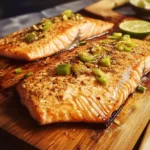
Cedar Plank Salmon Bbq recipe
Ingredients
- 1.5 lbs Salmon Fillet (Skin-on, Center-Cut preferred): The quality and type of salmon are paramount for a truly exceptional Cedar Plank Salmon BBQ. Choosing the right fillet ensures optimal flavor, texture, and cooking results.
- Salmon Type: While various types of salmon can be used, certain varieties are particularly well-suited for cedar plank grilling due to their fat content and flavor profile.
- King Salmon (Chinook): Often considered the pinnacle of salmon, King salmon is prized for its rich, buttery flavor and high fat content. This fat content is crucial for cedar plank grilling as it keeps the salmon incredibly moist and prevents it from drying out during cooking. King salmon imparts a luxurious, melt-in-your-mouth texture and a deeply satisfying flavor infused with cedar smoke.
- Sockeye Salmon (Red Salmon): Sockeye salmon is another excellent choice, offering a robust, “salmon-y” flavor and a firm, meaty texture. While leaner than King salmon, Sockeye still has enough fat to remain moist and flavorful when cedar plank grilled. Its distinct flavor profile stands up beautifully to the smoky cedar notes.
- Coho Salmon (Silver Salmon): Coho salmon is a milder and more versatile option, offering a delicate flavor and a medium-firm texture. It’s a good balance between flavor and affordability and works well for those who prefer a less intense salmon taste. Coho salmon also benefits greatly from the smoky infusion of cedar plank grilling.
- Atlantic Salmon (Farmed or Wild-Caught): Atlantic salmon, both farmed and wild-caught, can be used. Wild-caught Atlantic salmon tends to be leaner and has a more pronounced flavor. Farmed Atlantic salmon is generally fattier and more readily available. When using Atlantic salmon, especially farmed varieties, ensure you don’t overcook it to maintain moisture.
- Skin-On vs. Skin-Off: Skin-on salmon is highly recommended for cedar plank grilling. The skin acts as a protective barrier between the salmon flesh and the direct heat of the grill, helping to prevent sticking and keeping the salmon incredibly moist. Furthermore, the skin crisps up beautifully when placed directly on the plank during grilling, adding a delightful textural contrast. Center-cut fillets, which are thicker and more uniform, cook more evenly and are ideal for presentation and consistent results.
- Salmon Type: While various types of salmon can be used, certain varieties are particularly well-suited for cedar plank grilling due to their fat content and flavor profile.
- 1 Cedar Plank (Untreated, Food-Grade, approximately 12-15 inches long): The cedar plank is the defining element of this recipe, imparting its signature smoky aroma and flavor to the salmon. Choosing the right plank and preparing it correctly is essential for safety and flavor.
- Type of Cedar Plank: Use only untreated, food-grade cedar planks specifically sold for grilling. These planks are typically made from Western Red Cedar, known for its aromatic and food-safe properties. Avoid using lumberyard cedar, as it may be treated with chemicals that are not food-safe and can impart unpleasant flavors.
- Plank Size: A plank approximately 12-15 inches long and 5-7 inches wide is generally suitable for a 1.5 lb salmon fillet. Ensure the plank is large enough to comfortably accommodate the salmon fillet without overhang.
- Soaking the Plank: Soaking the cedar plank in water is a crucial step. Soaking prevents the plank from catching fire on the grill and allows it to smolder and release its smoky aroma slowly. Soak the plank for at least 2-4 hours, or ideally overnight, submerged in water. You can weigh it down with a heavy can or plate to keep it fully submerged. For added flavor, you can soak the plank in wine, beer, apple cider, or even broth instead of water, although water works perfectly well for a classic cedar flavor.
- 2 tablespoons Olive Oil (Extra Virgin): Olive oil is used to brush the cedar plank and the salmon fillet, preventing sticking and adding a subtle richness and flavor. Extra virgin olive oil is preferred for its robust flavor and health benefits.
- 2 tablespoons Lemon Juice, Freshly Squeezed: Fresh lemon juice brightens the flavor of the salmon, adds acidity, and complements the smoky cedar notes beautifully. Freshly squeezed lemon juice is crucial for its vibrant and fresh taste.
- 2 cloves Garlic, Minced: Minced garlic adds a savory, aromatic depth to the salmon that enhances its natural flavor and pairs well with the smoky cedar. Freshly minced garlic is preferred for its pungent and robust taste.
- 1 teaspoon Dried Dill (or 2 tablespoons Fresh Dill, chopped): Dill is a classic herb that pairs exceptionally well with salmon, adding a fresh, herbaceous, and slightly citrusy note that complements the smoky cedar and lemon. Dried dill is convenient, but fresh dill, when available, offers a more vibrant and aromatic flavor.
- Salt and Black Pepper to taste: Essential seasonings that enhance all the other flavors and bring the dish together. Seasoning to taste is crucial, as the amount needed can vary depending on individual preferences and the natural saltiness of the salmon. Kosher salt or sea salt and freshly ground black pepper are recommended for the best flavor.
- Optional Garnishes (for presentation and added freshness):
- Fresh Dill Sprigs: Fresh dill sprigs add a beautiful visual garnish and a burst of fresh dill aroma when serving.
- Lemon Slices or Wedges: Lemon slices or wedges provide an extra squeeze of fresh lemon juice at the table, enhancing the brightness and tanginess of the dish.
- Chopped Fresh Parsley: Chopped fresh parsley adds a pop of color and a fresh, herbaceous note.
Instructions
Step 1: Prepare the Cedar Plank (Crucial Pre-Grilling Step)
- Soak the Cedar Plank: Place the cedar plank in a large container or baking dish and cover it completely with water. Ensure the plank is fully submerged by weighing it down with a heavy can, plate, or bowl. Soak for at least 2-4 hours, or ideally overnight. Longer soaking times are preferable to ensure the plank is thoroughly saturated with water. This step is absolutely essential to prevent the plank from catching fire on the grill and to ensure it smolders and releases smoke instead of burning.
Step 2: Prepare the Salmon and Seasonings (Flavor Infusion)
- Pat Salmon Dry: Remove the salmon fillet from its packaging and pat it dry with paper towels. Patting the salmon dry helps seasonings adhere better and promotes better searing if you choose to sear it briefly before planking.
- Prepare Seasoning Mixture: In a small bowl, combine minced garlic, dried dill (or fresh dill), salt, and black pepper. Mix well to ensure the seasonings are evenly distributed.
- Season Salmon: Place the salmon fillet on a cutting board or plate. Drizzle olive oil over the top of the salmon fillet, spreading it evenly with your fingers or a brush. Sprinkle the seasoning mixture evenly over the salmon fillet, pressing gently to help the seasonings adhere. Squeeze fresh lemon juice over the seasoned salmon fillet, ensuring it is evenly distributed.
Step 3: Prepare the Grill (Setting the Stage for Smoky Grilling)
- Preheat Grill: Preheat your grill to medium heat (around 350-400°F or 175-200°C). Medium heat is ideal for cedar plank grilling, allowing the salmon to cook through gently and evenly without burning the plank or drying out the fish. If using a charcoal grill, arrange the coals for indirect heat, meaning you will place the plank and salmon away from the direct flames. For a gas grill, preheat with all burners on medium, then adjust as needed to maintain medium heat.
- Prepare Soaked Cedar Plank: Remove the soaked cedar plank from the water and pat it dry with paper towels. Patting it dry slightly helps to prevent excessive steaming initially and encourages the plank to start smoldering and smoking sooner.
Step 4: Grill the Cedar Plank Salmon (The Smoky Transformation)
- Place Plank on Grill: Place the soaked cedar plank directly on the preheated grill grates over indirect heat (if using charcoal) or on a cooler zone of the grill (if using gas). Close the grill lid and heat the plank for about 5-10 minutes, or until you start to hear it crackle and see it begin to smoke lightly. Heating the plank first preheats it and encourages it to start smoking before the salmon is placed on top. Watch closely to ensure the plank doesn’t catch fire. If it flames up, use a spray bottle of water to gently extinguish the flames.
- Place Salmon on Plank: Carefully place the seasoned salmon fillet, skin-side down, directly onto the preheated cedar plank on the grill. Close the grill lid.
- Grill Time and Temperature: Grill the cedar plank salmon for 15-20 minutes, or until the salmon is cooked through and flakes easily with a fork. The exact grilling time will depend on the thickness of the salmon fillet and the heat of your grill. Maintain medium heat throughout the grilling process. Avoid lifting the lid too frequently to maintain consistent temperature and smoke infusion.
- Check for Doneness: Salmon is cooked through when it flakes easily with a fork and is no longer translucent in the center. You can use a meat thermometer to check the internal temperature; it should reach 145°F (63°C). Be careful not to overcook the salmon, as it can become dry. Cedar plank grilling helps to prevent overcooking due to the gentle, indirect heat and the moisture released from the plank.
Step 5: Serve and Garnish (Presenting the Smoky Delight)
- Remove from Grill: Once the salmon is cooked through, carefully remove the cedar plank with the salmon from the grill using large tongs or spatulas. Place the plank on a heatproof serving platter or cutting board.
- Garnish (Optional): Garnish the cedar plank salmon with fresh dill sprigs, lemon slices or wedges, and chopped fresh parsley, if desired, for visual appeal and added freshness.
- Serve Immediately: Serve the Cedar Plank Salmon BBQ immediately while it is hot, flaky, and infused with smoky cedar flavor. You can serve the salmon directly from the plank for a rustic and impressive presentation, or carefully transfer the salmon fillet to a serving platter and discard the plank. Serve with your favorite sides (see serving suggestions below).
Nutrition
- Serving Size: one normal portion
- Calories: 500
- Sugar: 1-2g
- Sodium: 200-300mg
- Fat: 30-40g
- Saturated Fat: 5-8g
- Carbohydrates: 2-3g
- Fiber: 0-1g
- Protein: 40-50g
- Cholesterol: 120-150mg

